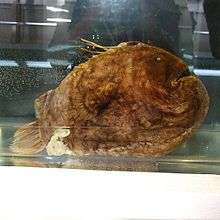Atlantic footballfish
| Atlantic footballfish | |
|---|---|
 | |
| Atlantic footballfish | |
| Scientific classification | |
| Kingdom: | Animalia |
| Phylum: | Chordata |
| Class: | Actinopterygii |
| Order: | Lophiiformes |
| Family: | Himantolophidae |
| Genus: | Himantolophus |
| Species: | H. groenlandicus |
| Binomial name | |
| Himantolophus groenlandicus J. C. H. Reinhardt, 1837 | |
The Atlantic footballfish (Himantolophus groenlandicus), also known as the man-gobbler, is an anglerfish found in extreme depths of the ocean. Despite its name, this species lives in all oceans, but is primarily found in cold and temperate regions.[1]
Description
Female Atlantic footballfish are about 61 cm (24 in) long, and weigh about 11 kg (24 lb).Males are much smaller, only 4 cm (1.6 in). The female's extremely rotund body is studded with bony plates, each bearing a central spine. The modified ray on the head makes a thick "fishing-rod", tipped with a lure on a central luminous bulb. It uses this to attract smaller fish in the dark abyss. Despite the male's tiny size, it is not parasitic, unlike the males of many other anglerfish.
Relationship with humans
Due to being found in the deep water, few human interactions have occurred. Despite its fearsome appearance, it poses no actual danger. It is of little food value.
Predators
Several specimens have been reported from the stomachs of sperm whales caught in the Azores.[2]
References
- ↑ "Himantolophus groenlandicus_Atlantic footballfish".
- ↑ CLARKE, R., 1956. "Sperm whales of the Azores". Discovery Reports, 28: 237-298, pis I-II.
- Longmann's Animal Encyclopedia